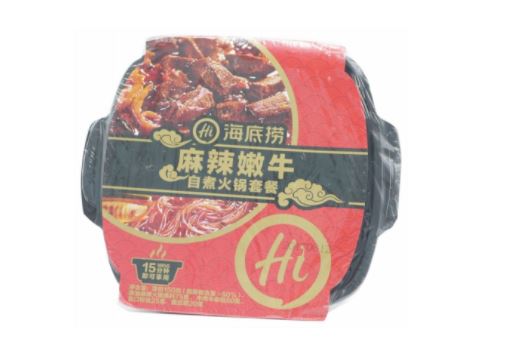The self-heating hot pot first appeared in China a couple years back, and following aggressive promotional activity by manufacturers and endorsements by famous Sichuan-based hot pot restaurants, began to achieve immense success in late 2017.
Self-heating hot pots require no external heat source (fire or electricity) in their preparation—all that is needed is just a bottle of water. The bottom of the packet contains a packet of quicklime which, when mixed with water, releases heat adequate for cooking the product.
Hai Di Lao Numbing Hot Delicate Beef DIY Hot Pot Meal
Inspiration from foodservice spurs innovation
Sichuan cuisine is arguably the most far-reaching and popular style of local cuisine among Chinese consumers. According to Mintel’s 2017 Menu Insights China report, half of Chinese consumers say that they frequently go for Sichuan options when dining out. China’s fondness for spicy foods is immense and long-standing, and the popularity of the hot pot isn’t simply because of its flavour but also for the social aspect that comes with it.
The self-heating hot pot could mark the beginning of a trend for turning food staples into snacking options. Manufacturers can turn to foodservice for inspiration in developing convenient, on-the-go offerings which tap into urban consumers’ fast-paced lifestyles.
A Sichuan foodie tests the flavour and ingredients of self-heating options.
More innovation for urban consumers
China is undergoing an accelerated urbanisation process, with more people moving from rural areas to the city or suburbs. The increasing pace of life that this brings calls for time-saving innovation, both in terms of food preparation and consumption, more so today as fewer consumers are now equipped with the time to cook from scratch all while having concerns about eating healthily.
For consumers who dine out, the inconvenience that comes with queueing for a table is generally seen as a waste of time. Food delivery services have therefore seen stable growth over the last few years—especially since consumers are looking for a convenient, delicious, quick food fix. In fact, back in 2016, Mintel research revealed that as many as four in five Chinese consumers ordered take-out food.
Bearing these factors in mind, innovation should centre around saving time and providing maximum nutritional content, and hot pot is well poised to fulfil these needs.
What we think
Manufacturers of the self-heating hot pot can further develop the product by providing more flavour choices away from the popular, spicy ones, with lighter soup flavours being of particular interest.
When it comes to ingredient content, producers can look to utilise less processed meat and fish—which is commonly perceived as being unhealthy—and adopt vacuum packaging to maintain freshness. Traditional packaged food manufacturers can take inspiration from the popularity of the self-heating hot pot, which has played a part in sparking the current trend for food staples becoming more snack-like.



















![[WATCH] Trending ingredients to watch: Hydroxydecyl Ubiquinone](https://www.mintel.com/app/uploads/2023/06/Hydroxydecyl-Ubiquinone-艾地苯_Digital_Blog_1000x305.jpg)
![[WATCH] Trending ingredients to watch: Monk Fruit](https://www.mintel.com/app/uploads/2023/06/Monk-Fruit-罗汉果_Digital_Blog_1000x305.jpg)



















